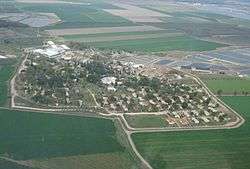Tirat Zvi
| Tirat Zvi טִירַת צְבִי | |
|---|---|
 | |
 Tirat Zvi | |
| Coordinates: 32°25′18″N 35°31′28″E / 32.42167°N 35.52444°ECoordinates: 32°25′18″N 35°31′28″E / 32.42167°N 35.52444°E | |
| District | Northern |
| Council | Valley of Springs |
| Affiliation | Religious Kibbutz Movement |
| Founded | 30 June 1937 |
| Founded by | European immigrants |
| Population (2015) | 759[1] |
| Website | tiratzvi.org.il |
Tirat Zvi (Hebrew: טִירַת צְבִי, lit. Zvi Castle) is a religious kibbutz in the Beit She'an Valley, ten kilometers south of the city of Beit She'an, Israel, just west of the Jordan River and the Israel-Jordan border. It falls under the jurisdiction of Valley of Springs Regional Council. In 2015 it had a population of 759.
Geography
Tirat Zvi sits 220 meters below sea level. On 21 June 1942, it recorded the highest daytime temperature in Asia (54°C; 129.2°F),[2] although the validity of this measurement has been questioned.[3]
History
The kibbutz was founded on 30 June 1937 as part of the tower and stockade settlement enterprise. The founders were Jews from Poland, Romania and Germany and came from two groups: Kvutzat Shahal and Kvutzat Rudges. The kibbutz was named after Rabbi Zvi Hirsch Kalischer, one of the fathers of the Zionist Movement and a leader of Hovevei Zion. The "tira" refers to a two-storey mud-brick structure purchased from the Arab landowner, Musa al-Almi.[4]
The kibbutz was attacked on 28 February 1938 by an armed Arab mob during the Arab revolt. The attack was repelled with many casualties on both sides.[4] On 20 February 1948, before the neighboring Arab nations officially joined the 1948 Arab–Israeli War, a battalion of the Arab Liberation Army led by Muhammed Safa attacked Tirat Zvi. The Arabs were repelled, after 60 of the attackers were killed. One kibbutz member Naftali Friedlander was killed in the fighting.
Economy
The kibbutz operates a meat processing factory, Tiv, which sells its products locally and abroad. Tirat Zvi is the largest date grower in Israel, with 18,000 trees.[5] The kibbutz also has a lulav business. Working with scientists from the Volcani Institute, Tirat Zvi developed a method of preserving the palm fronds for several months, allowing them to be harvested in the spring and sold in the fall, for use on the holiday of Sukkot. In 2009, it produced 70,000 lulavs.[5]
References
- ↑ "List of localities, in Alphabetical order" (PDF). Israel Central Bureau of Statistics. Retrieved 16 October 2016.
- ↑ "Eastern Hemisphere: Highest Temperature". World Meteorological Organization. Retrieved 2013-07-18.
- ↑ Christopher, Burt. "Hottest air temperatures reported on Earth". Weather Underground. Retrieved 18 July 2013. The record is questioned by Christopher C. Burt (one of the initiators of the WMO investigation into the now-disqualified El Azizia world record), who claims that the thermograph reading was incorrectly read and the correct reading is only 53°C, in which case Sulaibya in Kuwait holds the record for highest temperature in Asia with 53.6°C.
- 1 2 History of Kibbutz Tirat Zvi Yorav
- 1 2 Ashkenazi, Eli (30 September 2009). "Lulav growers: Egyptian imports are pushing down prices". Haaretz. Retrieved 29 September 2013.
- Edna Margolis, Isidor Margolis, R. Cohen & J. Cohen, Jew and Arab on the Border: A story of Religious Pioneering, Hapoel Hamizrachi of America, 1940, New York, Edited by Aaron Binnun.